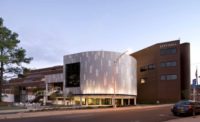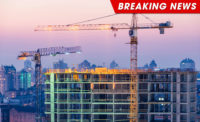The U.S. Green Building Council’s Leadership in Energy & Environmental Design (LEED) program became a prominent and widely used green standard when the federal government mandated its use on their buildings. Other consensus-based green standards lost momentum as architects who worked on federal projects saw restrictions in their design options. Architects tasked with designing energy-efficient buildings quickly adopted LEED’s point-based rating system on a variety of projects—not just those that were federally funded.
While there are numerous areas in which the LEED program has contributed to the USGBC’s stated purpose, which is “to help building operators save money and resources and have a positive impact on the health of occupants, while promoting renewable, clean energy,” there is one component of the LEED program that is having quite the opposite effect in certain situations.
Simply by using white or reflective roofing materials, builders can earn a LEED point for urban heat island mitigation. The urban heat island effect occurs in densely populated cities, where the temperature is a few degrees higher than surrounding rural areas. This is mainly attributable to the mass of concrete buildings, pavement, and asphalt road surfaces, along with a higher concentration of vehicles and people. Awarded under the Sustainable Sites Category, the LEED point for reflective roofing is based on the theory that white roofs will help a city stay cooler and therefore lower air conditioning demand and natural resource consumption for electricity generation. The concept of using white roofing materials to lower the average temperature of a city first took hold in Atlanta, Ga.—a warm, southern climate where this strategy seems logical.
The LEED point for installing a reflective roof to address urban heat islands is currently awarded regardless of whether a building is located in an urban environment and without consideration of the geographic climate. The use of reflective “cool” roofs became a simple and routine method for architects to increase their LEED point total as many of them were not aware of any downside, trade-offs, or unintended consequences associated with reflective roofing systems.
What the current LEED program doesn’t take into consideration is the heating penalty associated with using cool roofs in central and northern climates. Heating demand is typically 3-5 times greater than cooling demand in central and northern climates; therefore, cool roofs can contribute to higher overall energy consumption in these areas. Increased energy consumption leads to more CO2 emissions, which are known to be a major contributor to global warming.
A one-size-fits-all approach rarely works in the construction industry and, in this case, is having the opposite of the intended outcome. The U.S Environmental Protection Agency’s ENERGY STAR program advises that the energy savings provided by a white roof are highly dependent upon a building’s location and geographic climate and recommends using the U.S. Department of Energy’s Roof Savings Calculator to determine if the heating penalty exceeds the cooling benefit on a given project.
Beyond the additional heating burden in heating-dominated climates, the use of white roofs in central and northern parts of the country may be leading to other unintended environmental consequences. Research from Stanford University and Arizona State University has recently shown that widespread adoption of white roofs may have some negative environmental impacts, including decreased cloud cover, changes in rainfall patterns, and increased global temperatures.
Sunlight deflected into the atmosphere by reflective roofs can change cloud cover and reduce precipitation levels in some areas, according to a study by Arizona State University (“Urban Adaptation Can Roll Back Warming of Emerging Megapolitan Regions,” Matei Georgescu, Philip E. Morefield, et al, Proceedings of the National Academy of Sciences, Feb. 2014).
The same phenomenon may also increase global temperatures, according to a study by Stanford University (“Effects of Urban Surfaces and White Roofs on Global and Regional Climate,” Mark Z. Jacobson and John E. Ten Hoeve, Journal of Climate, Sept. 2011) that simulated what would happen if all the roofs in the United States were converted to white. The Stanford study determined this may lead to a net increase in global warming, as sunlight reflected by white roofs reflects heat back up into the atmosphere, where it mixes with black and brown soot particles to further warm the atmosphere.
In fairness to LEED, the Arizona State and Stanford studies came out after LEED established the criteria in which a point was awarded for using white roofs to address urban heat islands. Based on this new information, many LEED-certified architects are thinking twice about the automatic white roof point and are using the new studies to ensure their clients make a wise and environmentally sound decision when selecting a roof color.
We, as a leading manufacturer of white, tan, gray, and black roofing membranes, suggest the USGBC’s LEED program would be strengthened by limiting the LEED point for white roofs to urban or city settings in southern climates where cooling demand outweighs heating demand— typically ASHRAE Zones 1-3. The LEED point should be limited to settings where a white roof can help a building owner lower their overall energy consumption for heating/cooling purposes, thereby reducing CO2 emissions and contributing to the USGBC’s goals of environmental stewardship and natural resource conservation.





